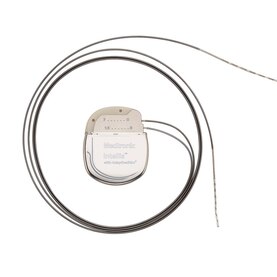Spinal Cord Stimulation (SCS)
If your chronic pain isn't responding to medication or other conservative therapies, you may be a candidate for spinal cord stimulation, also known as neurostimulation therapy.
What is Spinal Cord Stimulation? |
Spinal cord stimulation is delivered with a small spinal cord stimulator—similar to a pacemaker—that is implanted under the skin. The neurostimulator delivers mild electrical pulses to your spine, causing a tingling sensation in the area of your chronic pain. Spine Pain Diagnostics Associates now offers MRI-compatible neurostimulators.
|
How does it work? |
Spinal cord stimulation provides pain relief by modifying the pain messages before they reach the brain. The neurostimulator sends out mild electrical pulses that reach the brain faster than the pain signal can arrive. In other words, it outsmarts your back and leg pain. Instead of feeling pain, you feel a tingling sensation.
You can adjust the strength and location of stimulation using a handheld programmer. For example, you can regulate different levels of stimulation at different times of the day or for various activities, such as walking, sleeping, or sitting. |
What conditions are managed by it?
• Diabetic Neuropathic Pain
• Failed Back Syndrome (FBS) or low back syndrome or failed back
• Radicular pain syndrome or radiculopathies resulting in pain secondary to FBSS or herniated disk
• Postlaminectomy pain
• Multiple back operations
• Unsuccessful disk surgery
• Degenerative Disk Disease (DDD)/herniated disk pain refractory to conservative and surgical therapies
• Peripheral causalgia
• Epidural fibrosis
• Arachnoiditis or lumbar adhesive arachnoiditis
• Complex Regional Pain Syndrome (CRPS), Reflex Sympathetic Dystrophy (RSD), or causalgia
• Failed Back Syndrome (FBS) or low back syndrome or failed back
• Radicular pain syndrome or radiculopathies resulting in pain secondary to FBSS or herniated disk
• Postlaminectomy pain
• Multiple back operations
• Unsuccessful disk surgery
• Degenerative Disk Disease (DDD)/herniated disk pain refractory to conservative and surgical therapies
• Peripheral causalgia
• Epidural fibrosis
• Arachnoiditis or lumbar adhesive arachnoiditis
• Complex Regional Pain Syndrome (CRPS), Reflex Sympathetic Dystrophy (RSD), or causalgia
Components of SCS therapy
A complete spinal cord stimulation or neurostimulation system includes several components:
•Neurostimulator – The device, similar to a pacemaker, that sends mild electrical pulses and is usually surgically implanted under the skin in your abdomen or upper buttock
•Leads (pronounced “leeds”) – Thin, insulated medical wires that deliver neurostimulation to the epidural space near the spine
•Physician Programmer – A computer at your doctor’s office that lets your doctor adjust the neurostimulation system and set stimulation levels
•Handheld Programmer – A device similar to a remote control that you can use at home to optimize pain relief based on how your pain is changing throughout the day or during various activities
•Neurostimulator – The device, similar to a pacemaker, that sends mild electrical pulses and is usually surgically implanted under the skin in your abdomen or upper buttock
•Leads (pronounced “leeds”) – Thin, insulated medical wires that deliver neurostimulation to the epidural space near the spine
•Physician Programmer – A computer at your doctor’s office that lets your doctor adjust the neurostimulation system and set stimulation levels
•Handheld Programmer – A device similar to a remote control that you can use at home to optimize pain relief based on how your pain is changing throughout the day or during various activities
MRI-Compatible Neurostimulators
Spine Pain Diagnostics Associates is pleased to offer MRI-compatible neurostimulators. MRI scans allow physicians to make a wide range of health diagnoses by viewing highly detailed images of internal organs, blood vessels, muscle, joints, tumors, areas of infection and more. MRI uses strong magnetic fields and radio frequency pulses to create images of structures inside the body. While CT scans are used for imaging hard materials in the body, like bones, MRI scans are used to image soft tissue which is why MRI has become a standard of care in enabling the detection and treatment of serious medical conditions, including cancer, stroke and a variety of orthopedic conditions and neurologic conditions, such as chronic pain.

